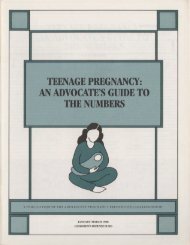child care - Digital Library Collections
child care - Digital Library Collections
child care - Digital Library Collections
You also want an ePaper? Increase the reach of your titles
YUMPU automatically turns print PDFs into web optimized ePapers that Google loves.
SPOTLIGHT ON HOUSING AND HOMELESSNESS<br />
• The rent levels used to determine Section 8 subsidies have been reduced, raising the share<br />
of rent paid by some families and increasing the likelihood that Section 8 units will be<br />
overconcentrated in low-income neighborhoods.<br />
• The long-standing requirement that a local housing authority must replace every unit of<br />
public housing lost through demolition or sale was suspended, creating a rush by housing<br />
agencies to tear down or sell off many properties. While one-for-one replacement of every<br />
unit lost is not always appropriate, in most communities it is desirable to replace the<br />
majority oflost units, because housing needs are still great.<br />
• Funding is not being provided for replacements, yet HUD continues to push for even more<br />
public housing demolitions, thereby reducing the stock ofaffordable housing still further.<br />
Some encouraging developments. Despite the troubling trends, there were some positive<br />
accomplishments and even a few signs of hope in 1997. Local housing and community<br />
development groups are building tens of thousands of new low-income units each year and in<br />
some cases helping to reclaim whole neighborhoods. They typically package federal fmancingfrom,<br />
for example, the Community Development Block Grant, the federal Low Income Housing<br />
Tax Credit, and the HOME program-with funds from state and local governments, foundations,<br />
and private sources, including key groups like the Local Initiatives Support Corporation,<br />
the Enterprise Foundation, and the Neighborhood Reinvestment Corporation. Efforts were<br />
under way in late 1997 to expand Section 8 funding in the FY 1999 federal budget that could be<br />
used in conjunction with these new development initiatives.<br />
A significant legislative achievement was that the Administration and Congress worked<br />
together to extend subsidies for the numerous Section 8 units for which funding was set to<br />
expire in FY 1998 or later. While this action will not increase the total number ofSection 8 units<br />
funded, and the subsidy amount per unit will shrink somewhat in the future, at least the current<br />
Section 8 units will not lose their assistance.<br />
A second achievement was a provision in the FY 1998 appropriations bill allowing HUD to<br />
restructure some Section 8 project-based assistance in a manner that will relieve some of the<br />
pressure on the HUD budget. It is not yet clear, however, how the Internal Revenue Service will<br />
treat these restructurings. If landlords participating in them receive relatively unfavorable tax<br />
treatment, many may opt out ofthe Section 8 program and raise their rents, which would force<br />
many low-income tenants to move out.<br />
Although Congress failed to provide enough funding for low-income housing, it stopped<br />
short of passing legislation that would fundamentally undermine the entire housing program.<br />
Since early 1995, lawmakers have been considering proposals that would drastically change the<br />
nation's housing assistance programs and worsen the housing crisis for very low-income<br />
families. In 1997 this legislation failed to pass for the third year in a row. It is too early to assume<br />
the battle is over, however, as Congress will be reconsidering the matter in 1998.<br />
The proposed legislation's most troublesome provisions would affect the future beneficiaries<br />
of public housing and Section 8 programs. Current recipients of such assistance earn, on<br />
average, only about 20 percent of the median income in the local area. The House measure<br />
would allow pubJjc housing authorities much wider latitude to primarily admit people earning<br />
between 50 and 80 percent of median income. Local agencies argue that they need some<br />
CHILDREN'S DEFENSE FUND 19














